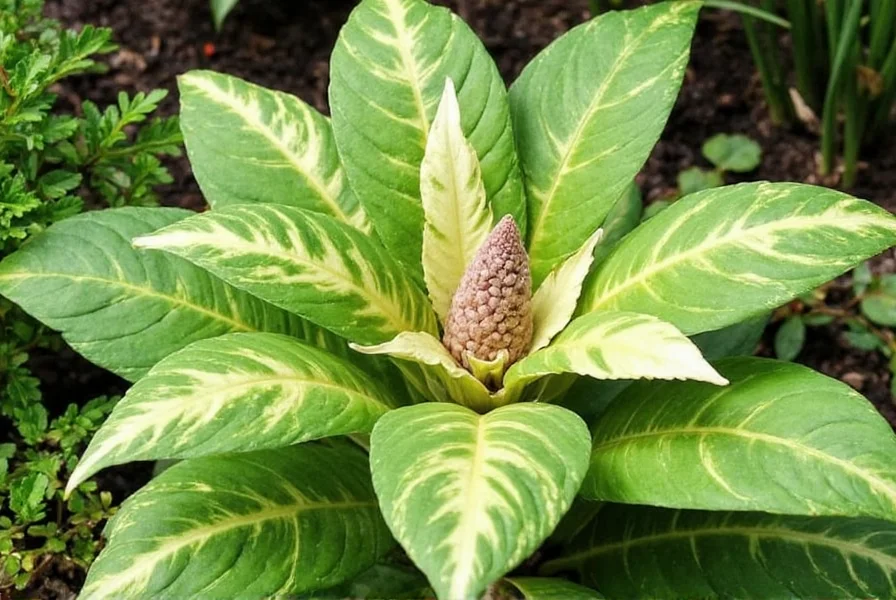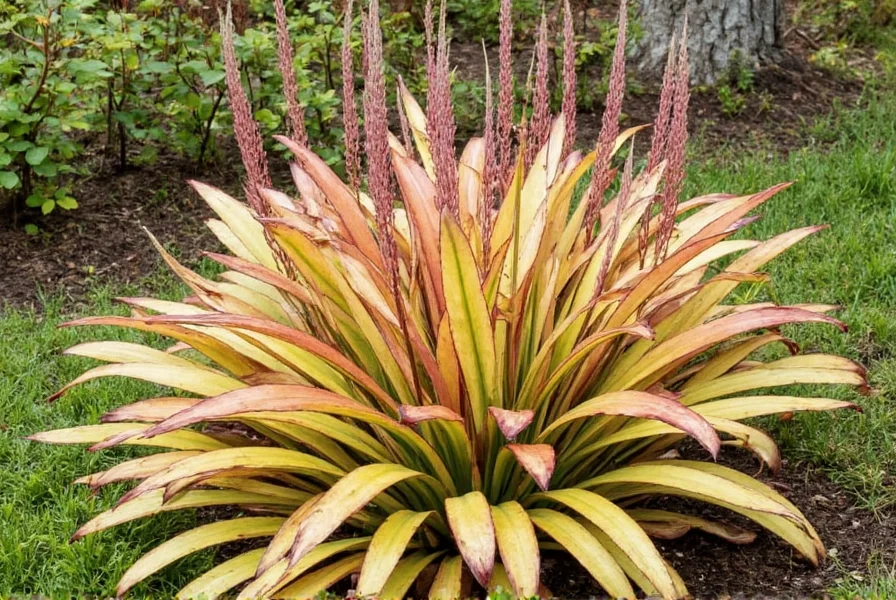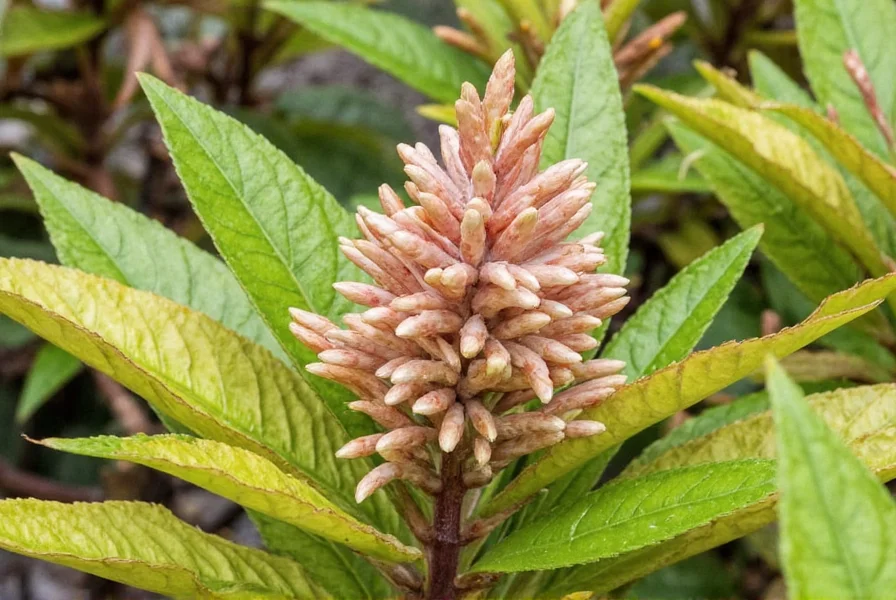Ginger Frost, scientifically classified as Zingiber officinale 'Ginger Frost', represents one of the most visually distinctive ornamental ginger varieties available to gardeners. This variegated cultivar stands apart from standard ginger plants through its unique foliage pattern that creates dramatic visual interest in shaded garden settings. While sharing the same botanical family as culinary ginger, Ginger Frost has been selectively bred for ornamental purposes rather than rhizome production.
Botanical Characteristics and Identification
Ginger Frost exhibits several distinctive features that make it easily identifiable among ginger varieties. The plant typically reaches 3-4 feet in height with a spread of 2-3 feet, forming dense clumps through its rhizomatous growth habit. Its most notable characteristic is the striking variegation pattern on the leaves—deep green centers contrast sharply with creamy white margins that widen as leaves mature. The leaf blades measure 6-8 inches wide and 12-18 inches long, with a smooth, glossy texture and prominent parallel venation.
Unlike culinary ginger varieties, Ginger Frost rarely produces flowers when grown outside tropical environments. When it does bloom, the flowers emerge as cone-like structures with yellowish-green bracts, though the foliage remains the primary ornamental feature. The plant's pseudostems (false stems formed by leaf sheaths) display a subtle reddish hue at the base, adding another dimension to its visual appeal.

Optimal Growing Conditions
Understanding the natural habitat of Ginger Frost is essential for successful cultivation. Native to tropical regions of Southeast Asia, this plant thrives in environments that mimic its natural understory conditions. The ideal temperature range spans 65-85°F (18-29°C), with protection required when temperatures drop below 50°F (10°C). While mature plants demonstrate some cold tolerance down to 30°F (-1°C) for brief periods, prolonged exposure to freezing temperatures will damage the foliage and potentially kill the rhizomes.
Light requirements represent a critical factor in maintaining Ginger Frost's distinctive variegation. The plant performs best in partial to full shade, with 2-4 hours of morning sun being acceptable in cooler climates. Direct afternoon sun will scorch the delicate variegated leaves, causing brown margins and reduced vigor. In indoor settings, position the plant near an east- or north-facing window, or provide filtered light through sheer curtains.
| Growing Factor | Optimal Range | Notes |
|---|---|---|
| Soil pH | 5.5-6.5 | Slightly acidic conditions promote best growth |
| Soil Type | Loamy, well-draining | Must retain moisture without becoming waterlogged |
| Water Needs | Consistently moist | Reduce frequency in winter dormancy |
| Fertilizer | Balanced 10-10-10 | Apply monthly during growing season |
Soil and Watering Requirements
The soil composition significantly impacts Ginger Frost's health and appearance. An ideal soil mix combines equal parts garden loam, peat moss, and perlite to create a rich, moisture-retentive yet well-draining medium. For container growing, use a high-quality potting mix amended with 20-30% perlite to improve aeration. The plant's rhizomes require oxygen as much as moisture, making proper drainage essential to prevent rot.
Watering practices should follow seasonal patterns. During active growth (spring through fall), maintain consistent soil moisture—water when the top inch of soil feels dry to the touch. Reduce watering frequency during winter dormancy, allowing the top 2-3 inches of soil to dry between waterings. Overwatering represents the most common cause of failure with Ginger Frost, particularly in cooler temperatures when the plant's water uptake slows.
Care and Maintenance Guidelines
Proper care ensures Ginger Frost maintains its striking variegation and vigorous growth. Fertilize monthly during the growing season with a balanced liquid fertilizer diluted to half strength. Organic options like fish emulsion or compost tea provide gentle nutrition while improving soil microbiology. Avoid high-nitrogen fertilizers, which can cause excessive green growth at the expense of variegation.
Pruning requirements are minimal for Ginger Frost. Remove yellowed or damaged leaves at the base to maintain appearance and prevent disease. In temperate climates, cut back foliage after the first frost to redirect energy to the rhizomes for winter survival. Container-grown plants benefit from annual repotting in spring, with division of the rhizome clump to control size and rejuvenate growth.

Propagation Techniques
Ginger Frost propagates primarily through rhizome division, the most reliable method for maintaining the plant's distinctive variegation. The optimal time for division coincides with the beginning of the growing season (spring). Carefully dig up the rhizome clump and use a clean, sharp knife to separate sections, ensuring each division contains at least one growing bud ("eye") and a portion of root system.
Allow divided rhizomes to dry for 24 hours before planting to reduce infection risk. Plant sections horizontally with the growing buds facing upward, covering with 1-2 inches of soil. Maintain warm, humid conditions until new growth emerges, typically within 3-6 weeks. While seed propagation is theoretically possible, it's rarely used as seeds don't reliably produce plants with the same variegation pattern.
Common Challenges and Solutions
Ginger Frost generally experiences fewer pest problems than many tropical plants, but several issues require attention. Spider mites represent the most common pest, particularly in dry indoor environments. Regular misting and periodic leaf washing help prevent infestations. For established problems, insecticidal soap or neem oil applications provide effective control without harming the plant.
Leaf discoloration often signals cultural issues. Brown leaf margins typically indicate underwatering or low humidity, while yellowing leaves suggest overwatering or poor drainage. Loss of variegation usually results from insufficient light—gradually increase light exposure to restore the distinctive pattern. Root rot, the most serious threat, manifests as wilting despite moist soil and requires immediate repotting with affected roots removed.
Landscaping Applications
Ginger Frost offers versatile landscaping possibilities in suitable climates. Its dramatic foliage creates striking contrast when paired with solid green plants like ferns or hostas. Use it as a focal point in shaded garden beds, along woodland borders, or as a specimen plant in containers. The plant's moderate height makes it ideal for mid-border placement, providing texture between shorter ground covers and taller backdrop plants.
In tropical and subtropical landscapes, Ginger Frost works well in mass plantings for dramatic visual impact. In temperate regions, container cultivation allows gardeners to enjoy the plant seasonally on patios or bring it indoors during winter months. The plant's tropical appearance enhances Asian-inspired gardens, while its variegation adds brightness to otherwise dark shaded areas.
Seasonal Considerations
Understanding Ginger Frost's seasonal growth patterns is crucial for proper care. The plant enters active growth in spring as temperatures warm, producing new shoots from the rhizomes. Summer represents the peak growing season, with maximum foliage production and potential flowering. As daylight decreases in fall, growth slows, and the plant begins preparing for dormancy.
In USDA zones 8-10, Ginger Frost typically dies back to the ground after the first frost but regrows from rhizomes in spring. In zone 7 and colder, gardeners must either treat it as an annual, dig and store rhizomes indoors, or provide substantial mulch protection. Container-grown plants should be moved to a protected location when temperatures drop below 50°F (10°C), with reduced watering during the winter rest period.
Conclusion
Ginger Frost offers gardeners a distinctive ornamental option that combines the tropical appeal of ginger plants with striking variegated foliage. By understanding its specific cultural requirements—particularly regarding light, moisture, and temperature—gardeners can successfully incorporate this unique plant into both landscape and container settings. Its dramatic leaf pattern creates visual interest in shaded areas where many other plants struggle, making it a valuable addition to diverse garden designs. With proper care, Ginger Frost provides year-round interest in warm climates and seasonal beauty in temperate regions, proving itself as a versatile and rewarding ornamental ginger variety.











 浙公网安备
33010002000092号
浙公网安备
33010002000092号 浙B2-20120091-4
浙B2-20120091-4